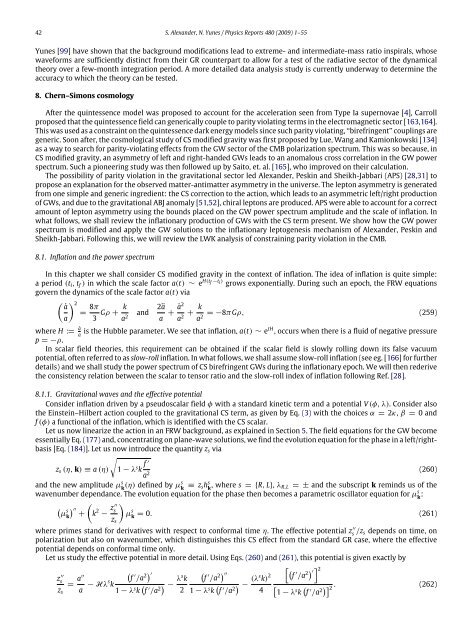Physics Reports ChernâSimons modified general relativity
Physics Reports ChernâSimons modified general relativity
Physics Reports ChernâSimons modified general relativity
You also want an ePaper? Increase the reach of your titles
YUMPU automatically turns print PDFs into web optimized ePapers that Google loves.
42 S. Alexander, N. Yunes / <strong>Physics</strong> <strong>Reports</strong> 480 (2009) 1–55Yunes [99] have shown that the background modifications lead to extreme- and intermediate-mass ratio inspirals, whosewaveforms are sufficiently distinct from their GR counterpart to allow for a test of the radiative sector of the dynamicaltheory over a few-month integration period. A more detailed data analysis study is currently underway to determine theaccuracy to which the theory can be tested.8. Chern–Simons cosmologyAfter the quintessence model was proposed to account for the acceleration seen from Type Ia supernovae [4], Carrollproposed that the quintessence field can generically couple to parity violating terms in the electromagnetic sector [163,164].This was used as a constraint on the quintessence dark energy models since such parity violating, ‘‘birefringent’’ couplings aregeneric. Soon after, the cosmological study of CS <strong>modified</strong> gravity was first proposed by Lue, Wang and Kamionkowski [134]as a way to search for parity-violating effects from the GW sector of the CMB polarization spectrum. This was so because, inCS <strong>modified</strong> gravity, an asymmetry of left and right-handed GWs leads to an anomalous cross correlation in the GW powerspectrum. Such a pioneering study was then followed up by Saito, et. al. [165], who improved on their calculation.The possibility of parity violation in the gravitational sector led Alexander, Peskin and Sheikh-Jabbari (APS) [28,31] topropose an explanation for the observed matter-antimatter asymmetry in the universe. The lepton asymmetry is generatedfrom one simple and generic ingredient: the CS correction to the action, which leads to an asymmetric left/right productionof GWs, and due to the gravitational ABJ anomaly [51,52], chiral leptons are produced. APS were able to account for a correctamount of lepton asymmetry using the bounds placed on the GW power spectrum amplitude and the scale of inflation. Inwhat follows, we shall review the inflationary production of GWs with the CS term present. We show how the GW powerspectrum is <strong>modified</strong> and apply the GW solutions to the inflationary leptogenesis mechanism of Alexander, Peskin andSheikh-Jabbari. Following this, we will review the LWK analysis of constraining parity violation in the CMB.8.1. Inflation and the power spectrumIn this chapter we shall consider CS <strong>modified</strong> gravity in the context of inflation. The idea of inflation is quite simple:a period (t i , t f ) in which the scale factor a(t) ∼ e H(t f −t i ) grows exponentially. During such an epoch, the FRW equationsgovern the dynamics of the scale factor a(t) via( ) 2 ȧ= 8π a 3 Gρ + k and 2äa 2 a + ȧ2a + k = −8πGρ, (259)2 a2 where H := ȧa is the Hubble parameter. We see that inflation, a(t) ∼ etH , occurs when there is a fluid of negative pressurep = −ρ.In scalar field theories, this requirement can be obtained if the scalar field is slowly rolling down its false vacuumpotential, often referred to as slow-roll inflation. In what follows, we shall assume slow-roll inflation (see eg. [166] for furtherdetails) and we shall study the power spectrum of CS birefringent GWs during the inflationary epoch. We will then rederivethe consistency relation between the scalar to tensor ratio and the slow-roll index of inflation following Ref. [28].8.1.1. Gravitational waves and the effective potentialConsider inflation driven by a pseudoscalar field φ with a standard kinetic term and a potential V(φ, λ). Consider alsothe Einstein–Hilbert action coupled to the gravitational CS term, as given by Eq. (3) with the choices α = 2κ, β = 0 andf (φ) a functional of the inflation, which is identified with the CS scalar.Let us now linearize the action in an FRW background, as explained in Section 5. The field equations for the GW becomeessentially Eq. (177) and, concentrating on plane-wave solutions, we find the evolution equation for the phase in a left/rightbasis[Eq. (184)]. Let us now introduce the quantity z s via√z s (η, k) ≡ a (η) 1 − λ s k f ′a 2 (260)and the new amplitude µ s (η) k defined by µs k ≡ z sh s k , where s = {R, L}, λ R,L = ± and the subscript k reminds us of thewavenumber dependance. The evolution equation for the phase then becomes a parametric oscillator equation for µ s k :)( )µs ′′k +(k 2 − z′′ sµ s k= 0. (261)z swhere primes stand for derivatives with respect to conformal time η. The effective potential z ′′s /z s depends on time, onpolarization but also on wavenumber, which distinguishes this CS effect from the standard GR case, where the effectivepotential depends on conformal time only.Let us study the effective potential in more detail. Using Eqs. (260) and (261), this potential is given exactly by[ (f ′ /a 2) ] ′2z ′′sz s= a′′a − Hλs k(f ′ /a 2) ′1 − λ ( s k f ′ /a 2) − λs k2(f ′ /a 2) ′′1 − λ ( s k f ′ /a 2) − (λs k) 24[1 − λ s k ( f ′ /a 2)] 2 . (262)



![arXiv:1001.0993v1 [hep-ph] 6 Jan 2010](https://img.yumpu.com/51282177/1/190x245/arxiv10010993v1-hep-ph-6-jan-2010.jpg?quality=85)


![arXiv:1008.3907v2 [astro-ph.CO] 1 Nov 2011](https://img.yumpu.com/48909562/1/190x245/arxiv10083907v2-astro-phco-1-nov-2011.jpg?quality=85)







![arXiv:1002.4928v1 [gr-qc] 26 Feb 2010](https://img.yumpu.com/41209516/1/190x245/arxiv10024928v1-gr-qc-26-feb-2010.jpg?quality=85)
![arXiv:1206.2653v1 [astro-ph.CO] 12 Jun 2012](https://img.yumpu.com/39510078/1/190x245/arxiv12062653v1-astro-phco-12-jun-2012.jpg?quality=85)
